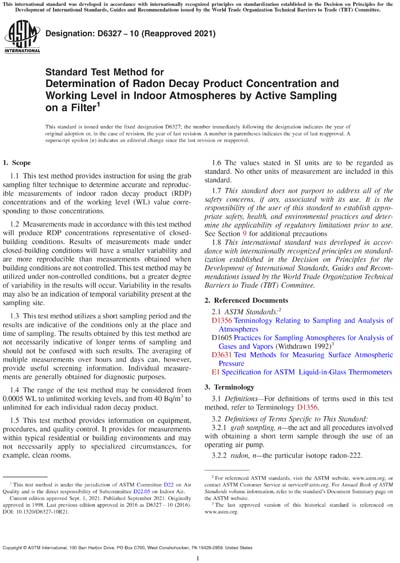Most recent
ASTM D6327-10(2021)
Standard Test Method for Determination of Radon Decay Product Concentration and Working Level in Indoor Atmospheres by Active Sampling on a Filter
1.1This test method provides instruction for using the grab sampling filter technique to determine accurate and reproducible measurements of indoor radon decay product (RDP) concentrations and of the working level (WL) value corresponding to those concentrations.
1.2Measurements made in accordance with this test method will produce RDP concentrations representative of closed-building conditions. Results of measurements made under closed-building conditions will have a smaller variability and are more reproducible than measurements obtained when building conditions are not controlled. This test method may be utilized under non-controlled conditions, but a greater degree of variability in the results will occur. Variability in the results may also be an indication of temporal variability present at the sampling site.
1.3This test method utilizes a short sampling period and the results are indicative of the conditions only at the place and time of sampling. The results obtained by this test method are not necessarily indicative of longer terms of sampling and should not be confused with such results. The averaging of multiple measurements over hours and days can, however, provide useful screening information. Individual measurements are generally obtained for diagnostic purposes.
1.4The range of the test method may be considered from 0.0005 WL to unlimited working levels, and from 40 Bq/m3 to unlimited for each individual radon decay product.
1.5This test method provides information on equipment, procedures, and quality control. It provides for measurements within typical residential or building environments and may not necessarily apply to specialized circumstances, for example, clean rooms.
1.6The values stated in SI units are to be regarded as standard. No other units of measurement are included in this standard.
1.7This standard does not purport to address all of the safety concerns, if any, associated with its use. It is the responsibility of the user of this standard to establish appropriate safety, health, and environmental practices and determine the applicability of regulatory limitations prior to use. See Section 9 for additional precautions
1.8This international standard was developed in accordance with internationally recognized principles on standardization established in the Decision on Principles for the Development of International Standards, Guides and Recommendations issued by the World Trade Organization Technical Barriers to Trade (TBT) Committee.
Content Provider
ASTM International [astm]






